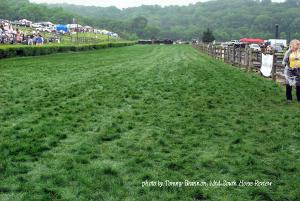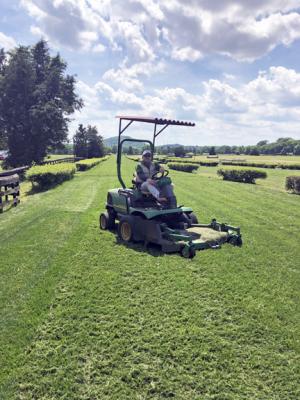By Tommy Brannon
On a wet and muddy day at this year’s Iroquois Steeplechase, May 11th in Nashville, Tenn., all of the racers, trainers, and spectators could notice how green, lush, and relatively free of mud the actual racetrack was. While the infield and parking areas were churned up by tailgating revelers, the track where the horses galloped at full speed and jumped had nearly perfect footing. This does not come by accident. Years of planning and preparation, as well as diligent hard work throughout the year, keep the track at Percy Warner Park ready for its one day a year of sport.
The tragic fatal horse injuries this year at racetracks in the U.S., such as Santa Anita, California, have brought to the forefront the challenge of providing and maintaining safe footing for racing. These fatal injuries have taken place on dirt tracks. None that we know of have happened on turf tracks.
Dwight Hall, Chairman of the Iroquois Steeplechase, takes a hands-on approach to providing one of the best steeplechase courses in the country. The Iroquois maintains the track, jumps, and seating, while Metro Parks and Recreation maintains the rest of the park. Although the race day crowd is a little hard on the park flora, a couple of weeks afterwards, hardly anyone would notice there had been any damage. No other horse activities except the seven races on Iroquois race day are allowed on the track itself. But there is a cross country event course in the infield and dressage arenas outside of the track used for the Middle Tennessee Pony Club horse trials.
Hall said that they have the race course footing maintenance down to a science, and most of it is done by one person. He uses the same formula for turf as the Masters Golf Course in Augusta, Georgia. The base consists of thick mat of Bermuda grass, which is over seeded by Champion GQ perennial rye grass. The Bermuda turf gives the track its bounce and the Rye grass gives it its color and texture. Bermuda grass, a perennial, loves hot humid weather, but goes dormant in the winter. Rye grass is an annual cool-weather grass that dies out in early summer. This combination makes for a firm and resilient base with just the right amount of solid footing the second weekend of May when the steeplechase takes place. The track has an elaborate computer-controlled Rain Bird sprinkler system with 23 different well divided zones and sprinkler heads that have the capability of spraying water up to 50 ft. Some sections of the track drain differently than others, but the entire course needs to have consistent footing, so different zones are watered at different rates. Moisture levels are measured in each zone. This information is entered into the computer and the system waters at the rate needed. September and October are usually the driest months in the mid-south and the track needs enough moisture to germinate seed.
A Cambridge Roller (cultipacker) is used throughout the growing season to smooth out and aerate the turf, and a golf course type mower is used to mow it. The track was mowed on Thursday before Saturday’s steeplechase to the target height of 5 to 5 ½ inches, which gives the track good cushion and keeps galloping hooves out of the deep turf.
Because of all the effort and expertise put into maintaining the steeplechase track at Percy Warner Park, even on a wet, rainy day, the horses and riders can confidently race and jump on a well-maintained turf course, neither of which sustained any injuries this year.









